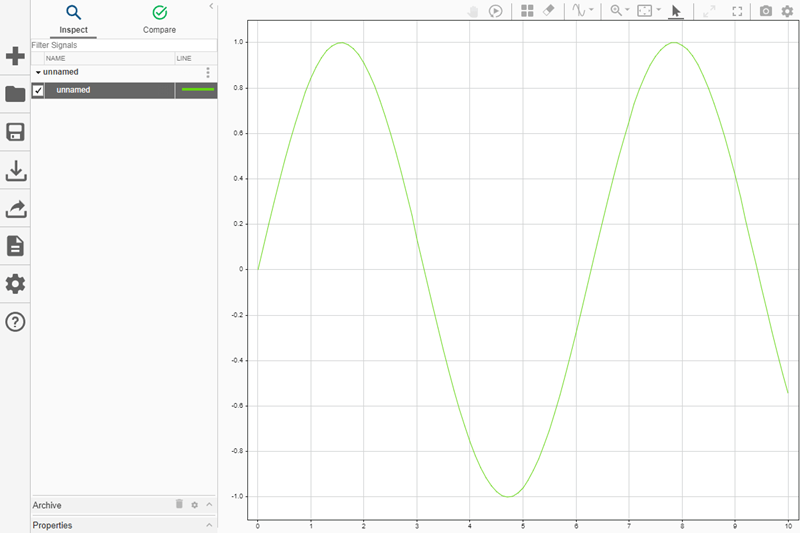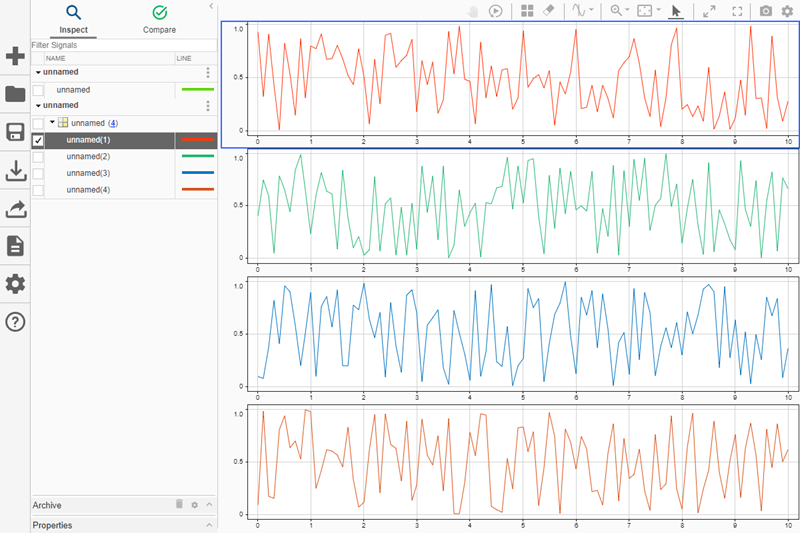Simulink.sdi.plot - Plot data in Simulation Data Inspector - MATLAB (original) (raw)
Plot data in Simulation Data Inspector
Syntax
Description
Simulink.sdi.plot([obj](#mw%5Fc0a3abf9-7c5f-4e17-9db2-6bb2834871f8)) opens the Simulation Data Inspector and plots the data in the object obj.
When the input object contains fewer than eight signals, the Simulation Data Inspector layout changes to 1-by-n, where n is the number of signals, and each subplot displays one signal. When the simulation results contain more than eight signals to plot, the Simulation Data Inspector layout changes to1-by-1, and the plot displays the first signal.
Simulink.sdi.plot([obj](#mw%5Fc0a3abf9-7c5f-4e17-9db2-6bb2834871f8),[runName](#mw%5Fb044efe1-74c9-4b24-94bf-06c3e6565233)) names the run runName when the data in obj does not already exist as a named run in the Simulation Data Inspector. If the data inobj already exists as a named run in the Simulation Data Inspector, the run is not renamed.
Simulink.sdi.plot([data](#mw%5F16253ff7-9ce2-48ce-85b0-dee1dc3ca2e1),[time](#mw%5F938f0b85-4bd3-43ce-86d6-52fc0c848e84)) plots data with respect to time in the Simulation Data Inspector.
[runObj](#mw%5F8b263d3c-f0da-4ca8-bc66-f9b19787c88a) = Simulink.sdi.plot(___) returns the Simulink.sdi.Run object that corresponds to the plotted data.
Examples
You can use the Simulink.sdi.plot function to plot simulation results in the Simulation Data Inspector. Open the model vdp, which models the second-order Van der Pol differential equation. For more information about the model, see Van der Pol Oscillator.
mdl = "vdp"; open_system(mdl)

Simulate the model. The model logs two signals: x1 and x2. Simulation results are stored in a single SimulationOutput object named out.
Use the Simulink.sdi.plot function to open the Simulation Data Inspector and plot the results.

You can use the Simulink.sdi.plot function to plot data with respect to time in the Simulation Data Inspector.
time = 0:0.1:10; data = sin(time); Simulink.sdi.plot(data,time);

You can also plot an array of data values in the Simulation Data Inspector. The number of rows in the data array must match the length of the time vector. The number of columns in the data array corresponds to how many signals are plotted.
dataArray = rand(length(time),4); Simulink.sdi.plot(dataArray,time);

Input Arguments
Run name, specified as a string or character vector.
The software only applies the run name runName to an unnamed run. If a named run with some or all of the data in obj already exists in the Simulation Data Inspector, the run is not renamed. When you create a run by simulating a model that logs data, the run name is automatically generated according to the run-naming rule in the Simulation Data Inspector. You can modify the run-naming rule in the Simulation Data Inspector in the UI or by using the Simulink.sdi.setRunNamingRule function.
To rename a run, you can use the Name property. For example,myRun.Name = myRunName sets the Name property of the Run object myRun tomyRunName. The workspace variable name for the run (myRun) does not change when you set the Name property.
Sample times, specified as a numeric scalar or vector, or a cell array of date character vectors. The table lists forms for valid date character vectors.
| Format | Example |
|---|---|
| dd-mmm-yyyy HH:MM:SS | 01-Mar-2000 15:45:17 |
| dd-mmm-yyyy | 01-Mar-2000 |
| mm/dd/yy | 03/01/00 |
| mm/dd | 03/01 |
| HH:MM:SS | 15:45:17 |
| HH:MM:SS PM | 3:45:17 PM |
| HH:MM | 15:45 |
| HH:MM PM | 3:45 PM |
| mmm.dd,yyyy HH:MM:SS | Mar.01,2000 15:45:17 |
| mmm.dd,yyyy | Mar.01,2000 |
| mm/dd/yyyy | 03/01/2000 |
Data Types: double | single | int8 | int16 | int32 | int64 | uint8 | uint16 | uint32 | uint64 | cell
Data to plot in the Simulation Data Inspector, specified as a numeric orlogical scalar, vector, or multidimensional array. The size of thedata argument must correspond to the size of thetime argument:
- When
datais a scalar,timemust also be a scalar. - When
datais a vector,timemust also be a vector of the same length. - When
datais a multidimensional array,timemust be a vector with a length equal to the number of rows indata.
Data Types: single | double | int8 | int16 | int32 | int64 | uint8 | uint16 | uint32 | uint64 | logical
Complex Number Support: Yes
Output Arguments
Version History
Introduced in R2019b
See Also
Objects
- Simulink.SimulationData.BlockPath | Simulink.SimulationData.Signal | Simulink.SimulationData.DataStoreMemory | Simulink.SimulationData.Dataset | timeseries | timetable
Functions
- plot | plotOnSubPlot | get | addElement